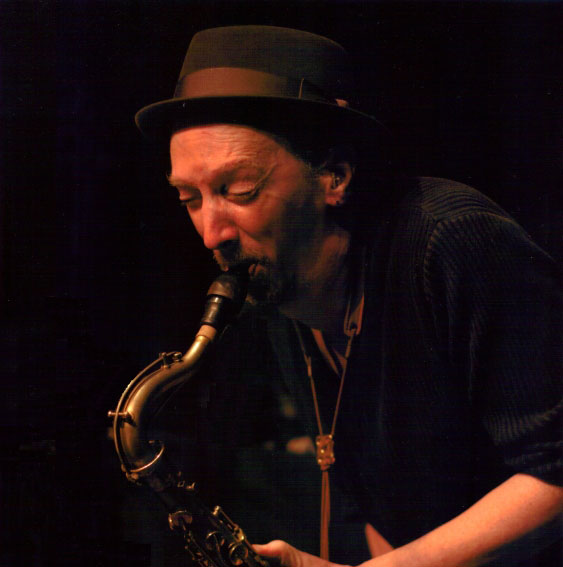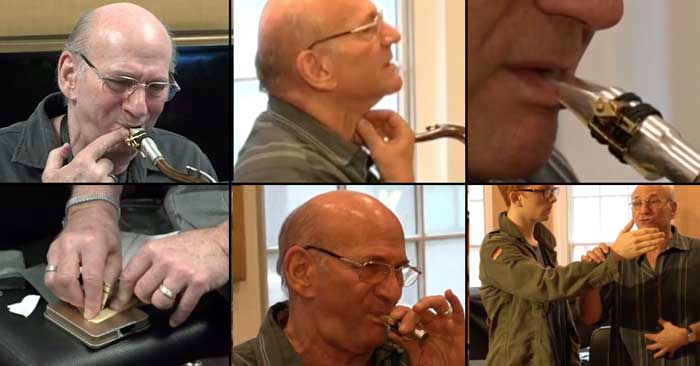Ellery Eskelin Talks Tunes, Tone, Improv and So Much More

The very survival of any artform depends on its ability to continually move forward and progress. Otherwise it becomes more of a museum exhibit than a living, breathing, and ever-expanding medium. Like any other artform, jazz requires the leadership of fearless and authentic artists to keep it alive and breathing, and without a doubt, renown New York tenor man, Ellery Eskelin is just one of those artists.
Coming up in a music-centered household, Ellery made the move to New York City in 1983 and has since appeared in a gaggle of groups and on a truckload of albums as both a leader and a sideman. The exhaustive list of Ellery’s esteemed cohorts includes folks like Drew Gress, Jim Black, Gerry Hemingway, Mark Helias, Bobby Previte, Brother Jack McDuff, Daniel Humair and the list goes on.
Upon listening to his playing, it becomes clear that Ellery’s improvisational vocabulary is anything but predetermined. With heaps of awards and accolades from publications such as New York Times, The Village Voice, and Downbeat, Ellery has carved out a wide niche for himself as a true musical free spirit. His musical journey consists of prodigious yet unorthodox forays into the realm of seemingly disparate styles such as free, as well as more “inside” jazz, avante-pop, and generally speaking, music that doesn’t fit neatly into any particular predefined slot.
The Interview
Doron Orenstein: What was it that inspired you to make music your life?
Ellery Eskelin: My mother played Hammond organ professionally in Baltimore in the early 60’s. She learned to play in the Pentecostal church, so she had a very strong sense of swing and command at the organ. As a kid I grew up hearing music in the house, standards mostly. I would also listen to jazz records from her collection. She could tell I was interested in music before I even really knew it myself. One night she asked me what instrument I would play if given the choice. I hadn’t thought about it before but in that moment of being asked, the thought of playing tenor saxophone came my mind with a surprising certainty. We rented one from the shop my grandfather worked at (he played and taught guitar). That very first day I knew I wanted to be a jazz musician. I was ten years old.
DO: You’ve played in so many different non-standard musical settings. While so many musicians with your jazz background stay within the realm of straight-ahead jazz, what do you think it was about your musical development that allowed you to develop uniqueness that you’ve achieved with your music?
EE: I guess I never felt that there was any kind of dichotomy between so called traditional jazz and so called avant-garde. John Coltrane demonstrated a clear trajectory in that respect. The first time I heard recordings of his like “Sun Ship” or “Interstellar Space” I was quite young and just starting out. At first I couldn’t figure out why anyone would want to make the kinds of sounds on the horn that he was making. These were often the kinds of sounds I was struggling not to make as a beginner. But a few years later when I was about seventeen or so I put those records on again and the music was revelatory. I heard that he was making music with all the possible sounds that you could make on a saxophone. And so the message I took from this was that jazz is a music of personal expression.
DO: When it comes to your approach to improvisation, your melodic vocabulary is anything but standard. In a nutshell, Is there anything you could recommend that improvisors do in order to expand their musical vocabulary beyond the standard jazz “vernacular?”
EE: In my case, at a certain point I began thinking of the saxophone as anything but a saxophone. I would try emulating the sound of a string quartet or a big band or an orchestra or a rock band. Or sometimes I would simply look out my window and try to translate the movement of the city into musical phrasing on the horn. Impossible tasks really. But in a practical sense this required breaking up my phrasing. Taking apart and putting back together musical ideas (melodic, rhythmic, textural) in as many ways as I could figure out. I was also listening to all kinds of music. In fact, there was a long stretch of time where I stopped listening to jazz and particularly saxophone players because I felt the influence was too heavy.
DO: What do you find yourself practicing the most these days?
EE: These days I’m back to listening to jazz and in particular, focusing very heavily on players from the 20’s, 30’s and 40’s. I’m trying to decode the early saxophone sound. That full, round, rich tone and delivery. So my practice is very elemental, almost akin to what we all do in the beginning with the raw materials. Incidentally, this coincides very well with teaching in as much as I’m practicing many of the same kinds of things that I offer to students. Long tones, slow playing, just getting from one note to another with control and awareness. Except now I have a much more holistic perspective having been playing for as many years as I have. I want to integrate everything I know and have experienced into a single musical utterance. To be able to play something very simple while expressing some depth and complexity.
A typical day of practice for me might involve choosing a song that catches my ear (usually something from the early tradition) and using the piano to learn it by ear from a recording; melody and harmony (always looking for the best voice leading). Once I have it I then transpose it into other keys so that I strengthen my perception of the overall form (in terms of chord function). Then I pick up the horn and apply what I’ve learned on the piano to the saxophone. Playing the melody, moving slowly through the harmony, improvising with spontaneous, simple straightforward melodies and lines. I want to be able to express the tune clearly enough that a listener could tell what tune I was improvising on even if they hadn’t heard me play the melody. Then I transpose the tune into different keys on the horn, usually looking for the keys that seem to be hardest to get through. All of this just to get to the starting point. Once I know the tune inside and out, I feel free enough to simply play by ear.
As such, I feel that rhythm is primary. Your rhythmic impulse determines your phrasing. From that comes a melodic idea. The strength of that melodic idea is determined greatly by it’s intervallic qualities and direction. There was a long stretch of time years back when I worked very hard on hearing and playing freely chosen interval combinations. I developed a melodic language that was not derived from chords. This work then informed the way I hear melodies when playing over chord changes. I’ve discovered that you can play all the “right notes” and if your melodies are weak you can sound totally wrong. And yet if your melodies are strong you can use all the so called “wrong notes” and sound totally convincing. You have to be playing what you hear and meaning it. In essence, your knowledge of the harmony guides you but never locks you in. We don’t play “on” the chords as much as we play “through” them. It’s all about movement.
DO: What would you say is the skill or attribute that’s helped you the most as a musician?
EE: I’m always trying to maintain a direct ear to horn connection, just like when singing. Everything I practice is oriented towards this idea.
DO: What’s the single best piece of advice you’ve been given over the course of your playing career?
EE: I can’t say that there is any single piece of advice that I’ve been given that qualifies as “best”. Most of the important lessons that I’ve learned from others have been experiential.
DO: What’s the next musical frontier for Ellery Eskelin?
EE: Simply to continue the process each and every day.
DO: For those new to your music, which recording would you suggest they pick up?
EE: My latest recording is Trio New York, which I feel best demonstrates where I’m at in the present moment. It’s a collection of standards with tenor saxophone, Hammond B3 organ (Gary Versace) and drums (Gerald Cleaver). But the material is treated rather loosely. We are essentially improvising freely in every way with these songs. It’s available from my web site.
DO: What’s your saxophone equipment setup?
- 1927 Conn tenor saxophone.
- Theo Wanne “Ambika” or Lebalye “LR II” hard rubber #8 (both are large chamber). I also have a Francois Louis hard rubber.
- Vandoren blue box number 2½ reeds.
To learn more about Ellery, check out his web site at http://home.earthlink.net/~eskelin or his blog at http://elleryeskelin.blogspot.
http://youtu.be/ne51PsYaKNw






June 25, 2012 @ 9:07 am
Great interview! I’ve been a fan of Mr. Eskelin’s music for many years. Both his sound and conception are unique, clear, ever-evolving and beautiful. I especially appreciate his thoughts on practice: slow things down; increase awareness; attend to the basics; deepen the ear to horn connection. All this leads to improvising on a very expansive and personal level. My favorite quote from the interview: ” Most of the important lessons that I’ve learned from others have been experiential.” I couldn’t agree more. Doron, thanks for another wonderful effort, and for bringing this highly significant artist to the attention of your readers.
June 25, 2012 @ 10:30 pm
Hey Bill! So glad that you liked the interview – Ellery does indeed have some incredible information to share. It’s great to get these types of insights from someone with such an expansive and open-ended musical vocabulary. Just like you said, “attend to the basics.”